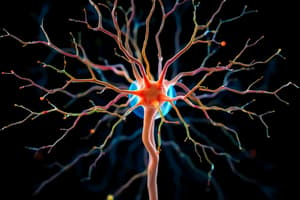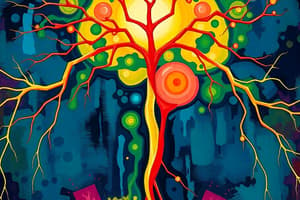Podcast
Questions and Answers
Soft-bodied fossils are common due to their resistance to decomposition.
Soft-bodied fossils are common due to their resistance to decomposition.
False (B)
What is the term for a change in DNA base sequence where one or more nucleotide bases are added to a gene?
What is the term for a change in DNA base sequence where one or more nucleotide bases are added to a gene?
Insertion mutation
A silent mutation occurs when a change in the DNA sequence results in the same ______ being produced.
A silent mutation occurs when a change in the DNA sequence results in the same ______ being produced.
amino acid
Which type of mutation is generally considered the least detrimental?
Which type of mutation is generally considered the least detrimental?
Match the following terms with their descriptions:
Match the following terms with their descriptions:
What is Kallmann syndrome primarily caused by?
What is Kallmann syndrome primarily caused by?
Acromegaly occurs during childhood due to excessive growth hormone production.
Acromegaly occurs during childhood due to excessive growth hormone production.
What is homeostasis?
What is homeostasis?
Dwarfism can be categorized into two types: proportionate and __________.
Dwarfism can be categorized into two types: proportionate and __________.
Which condition results from the pituitary gland producing too much growth hormone?
Which condition results from the pituitary gland producing too much growth hormone?
Match the following conditions with their descriptions:
Match the following conditions with their descriptions:
The pineal gland helps prepare the body for sleep.
The pineal gland helps prepare the body for sleep.
What are the two main systems that help maintain homeostasis?
What are the two main systems that help maintain homeostasis?
What is the primary function of a gene?
What is the primary function of a gene?
RNA is a double-stranded molecule similar to DNA.
RNA is a double-stranded molecule similar to DNA.
Which hormone is released by the pancreas to raise blood sugar levels?
Which hormone is released by the pancreas to raise blood sugar levels?
Cortisol is involved in managing both long-term stress and blood sugar levels.
Cortisol is involved in managing both long-term stress and blood sugar levels.
What is the role of messenger RNA (mRNA) in protein synthesis?
What is the role of messenger RNA (mRNA) in protein synthesis?
What are the glands located above the kidneys that produce hormones to manage stress called?
What are the glands located above the kidneys that produce hormones to manage stress called?
The four nucleotides in DNA are adenine, cytosine, guanine, and ______.
The four nucleotides in DNA are adenine, cytosine, guanine, and ______.
Match the following components of protein synthesis with their functions:
Match the following components of protein synthesis with their functions:
The _______________ is a gland in the neck that produces hormones controlling metabolism.
The _______________ is a gland in the neck that produces hormones controlling metabolism.
What is the primary function of the endocrine system?
What is the primary function of the endocrine system?
Match the following hormones with their functions:
Match the following hormones with their functions:
The promoter region signals RNA polymerase to start transcription.
The promoter region signals RNA polymerase to start transcription.
What is the process called where the body maintains balance by adjusting hormone levels?
What is the process called where the body maintains balance by adjusting hormone levels?
What can lead to species developing new characteristics for survival?
What can lead to species developing new characteristics for survival?
Natural selection can result in intermediate traits becoming more common within a population.
Natural selection can result in intermediate traits becoming more common within a population.
What are the three ways natural selection can alter species?
What are the three ways natural selection can alter species?
Burning of fossil fuels increases the amount of __________ in the air.
Burning of fossil fuels increases the amount of __________ in the air.
Which trait variation is favored in disruptive selection?
Which trait variation is favored in disruptive selection?
Deforestation can contribute to an increase in carbon dioxide levels.
Deforestation can contribute to an increase in carbon dioxide levels.
Match the following cycles with their respective problems:
Match the following cycles with their respective problems:
An example of a trait that can influence survival is __________ color in mice.
An example of a trait that can influence survival is __________ color in mice.
What is the primary role of hormones in the endocrine system?
What is the primary role of hormones in the endocrine system?
Positive feedback mechanisms work to decrease hormone levels in the body.
Positive feedback mechanisms work to decrease hormone levels in the body.
Name the gland that connects the endocrine system with the nervous system.
Name the gland that connects the endocrine system with the nervous system.
The _____ detect changes in the environment and send signals to the control center.
The _____ detect changes in the environment and send signals to the control center.
Which gland is NOT considered a major gland of the endocrine system?
Which gland is NOT considered a major gland of the endocrine system?
Glands in the endocrine system release hormones directly into the bloodstream.
Glands in the endocrine system release hormones directly into the bloodstream.
Match the following glands with their primary function:
Match the following glands with their primary function:
The brain or spinal cord that processes information is called the _____ center.
The brain or spinal cord that processes information is called the _____ center.
Flashcards
Gene
Gene
A section of DNA that contains the instructions for building a specific protein.
Transcription
Transcription
The process of copying genetic information from DNA into messenger RNA (mRNA).
Genetic Mutation
Genetic Mutation
A change in the sequence of nucleotides in DNA.
Guanine (G)
Guanine (G)
Signup and view all the flashcards
Messenger RNA (mRNA)
Messenger RNA (mRNA)
Signup and view all the flashcards
Hormones
Hormones
Signup and view all the flashcards
Endocrine system
Endocrine system
Signup and view all the flashcards
Glands
Glands
Signup and view all the flashcards
Hypothalamus
Hypothalamus
Signup and view all the flashcards
Receptors
Receptors
Signup and view all the flashcards
Control center
Control center
Signup and view all the flashcards
Effectors
Effectors
Signup and view all the flashcards
Feedback mechanism
Feedback mechanism
Signup and view all the flashcards
What is homeostasis?
What is homeostasis?
Signup and view all the flashcards
What is the hormonal system?
What is the hormonal system?
Signup and view all the flashcards
What is Kallmann syndrome?
What is Kallmann syndrome?
Signup and view all the flashcards
What is dwarfism?
What is dwarfism?
Signup and view all the flashcards
What is gigantism?
What is gigantism?
Signup and view all the flashcards
What is acromegaly?
What is acromegaly?
Signup and view all the flashcards
What is Cushing syndrome?
What is Cushing syndrome?
Signup and view all the flashcards
What is the hypothalamus?
What is the hypothalamus?
Signup and view all the flashcards
What are the adrenal glands and their function?
What are the adrenal glands and their function?
Signup and view all the flashcards
What is the endocrine system?
What is the endocrine system?
Signup and view all the flashcards
What are hormones?
What are hormones?
Signup and view all the flashcards
What is glucagon and its function?
What is glucagon and its function?
Signup and view all the flashcards
What is insulin and its function?
What is insulin and its function?
Signup and view all the flashcards
What is the thyroid gland and its function?
What is the thyroid gland and its function?
Signup and view all the flashcards
What is a feedback system?
What is a feedback system?
Signup and view all the flashcards
What is the pancreas and its function?
What is the pancreas and its function?
Signup and view all the flashcards
Environmental Changes
Environmental Changes
Signup and view all the flashcards
Trait Variation
Trait Variation
Signup and view all the flashcards
Advantageous Trait
Advantageous Trait
Signup and view all the flashcards
Adaptation
Adaptation
Signup and view all the flashcards
Natural Selection
Natural Selection
Signup and view all the flashcards
Directional Selection
Directional Selection
Signup and view all the flashcards
Disruptive Selection
Disruptive Selection
Signup and view all the flashcards
Stabilizing Selection
Stabilizing Selection
Signup and view all the flashcards
Point Mutation
Point Mutation
Signup and view all the flashcards
Silent Mutation
Silent Mutation
Signup and view all the flashcards
Insertion Mutation
Insertion Mutation
Signup and view all the flashcards
Deletion Mutation
Deletion Mutation
Signup and view all the flashcards
Insertions and Deletions
Insertions and Deletions
Signup and view all the flashcards
Anatomy of Species
Anatomy of Species
Signup and view all the flashcards
Homologous Structures
Homologous Structures
Signup and view all the flashcards
Fossil Evidence
Fossil Evidence
Signup and view all the flashcards
Study Notes
The Nervous System
- Controls and interprets body activities
- Gathers information from internal and external sources
- Sends information to muscles, glands, and organs
- Processes information to determine the best response
Neurons
- Basic functional units of the nervous system
- Carry information via nerve impulses
- Contain dendrites (receive signals), axons (transmit signals), and cell bodies (nuclei)
Parts of the Nervous System
-
Central Nervous System (CNS): Command center
- Brain: Control center for sensory information, thoughts, emotions, and body functions
- Cerebrum: Largest part, 2 hemispheres, controls voluntary movement
- Cerebellum: Coordinates muscle actions, balance, and movement
- Brainstem: Coordinates vital functions (breathing, heart rate, sleep)
- Spinal cord: Highway for information between brain and body; coordinates reflexes
- Brain: Control center for sensory information, thoughts, emotions, and body functions
-
Peripheral Nervous System (PNS): Network of nerves connecting body to CNS
- Somatic Nervous System: Controls voluntary movements
- Autonomic Nervous System: Controls involuntary functions (heart rate, digestion)
- Sympathetic Nervous System: "Fight or flight" response
- Parasympathetic Nervous System: "Rest and digest" response
Neurological Disorders
- Cerebral Palsy: Lack of full physical control, muscle tightness
- Parkinson's Disease: Movement disorder, tremors start in hands
- Brain Tumor: Formed in meninges (brain/spinal cord coverings)
- Epilepsy: Abnormal neuron activity, seizures
- Alzheimer's Disease: Severe mental deterioration, brain size reduction
- Encephalitis: Inflammation of the brain (infection)
- Meningitis: Inflammation of the meninges
- Rabies: Viral infection; transmitted by animal bites
- Tetanus: Bacterial infection causing muscle spasms
Endocrine System
- Network of glands that produce and release hormones
- Hormones act as chemical messengers, regulating body functions
- Major glands: Hypothalamus, pituitary, thyroid, adrenal, pancreas, ovaries, testes
Homeostasis
- Process of maintaining internal balance (e.g., temperature, blood sugar)
- Uses control systems (nervous and endocrine)
Endocrine Disorders
- Hypothalamic Disease: Issues in the hypothalamus
- Kallmann Syndrome: Deficiency in hormone production
- Dwarfism: Slowed growth due to insufficient growth hormone
- Gigantism: Excessively high growth hormone levels
- Acromegaly: Excess growth hormone in adulthood
- Cushing Syndrome: High cortisol levels
Protein Synthesis
- DNA to RNA (transcription): Copying a gene's instructions to mRNA in the nucleus
- RNA to Protein (translation): Ribosomes synthesize proteins in the cytoplasm based on mRNA instructions.
Evolution
- Variations in traits among organisms
- Natural Selection: beneficial traits increase survival and reproduction
- Adaptation: species develop traits for successful survival in their environment.
Studying That Suits You
Use AI to generate personalized quizzes and flashcards to suit your learning preferences.




